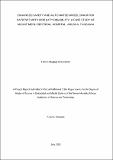Enhanced safety and automated wheelchair for patients with mobility disability: a case study of mount Meru referral hospital, Arusha, Tnzania
Abstract
Physical disability remains a challenging problem in Tanzania. The number of people with
physical disabilities is increasing every day for a variety of reasons. A wheelchair is one of
the devices that assists these people in their daily lives. Various wheelchair designs have been
developed, but the prevailing issue is that the existing systems continue to fall short of
meeting the needs of the users. There is a great need for a design that can meet some of these
people's needs, with safety as a top priority. To address these issues, the study intends to
develop an enhanced safety and automated wheelchair for patients with mobility disabilities.
The proposed system was a solar-powered wheelchair with some unique safety features for
wheelchair users. The wheelchair was built with a joystick for mobility, an MQ-2, a Global
System of Mobile communication (GSM), a Global Positioning System (GPS), an Ultrasonic
sensor, a buzzer, a pushbutton, a solar panel, a lead-acid battery, and an Atmega 328P
processor. Based on some of the previously mentioned important components, the system
was able to detect fire once by making a sound via the buzzer, and family members were able
to obtain any message if the wheelchair user was in danger simply by pressing the push
button. Furthermore, the system was capable of tracking location based on wheelchair user
consent and detecting obstacles within a 10cm range. The newly built prototype has a quick
response time while maneuvering around with the joystick, and solar power can last for less
than 3 hours

